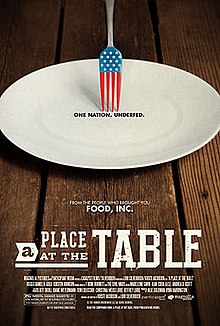 A Place at the Table
A Place at the TableA Place at the Table is a 2012 documentary film directed by Kristi Jacobson and Lori Silverbush, with appearances by Jeff Bridges, Raj Patel, and chef Tom Colicchio. The film, concerning hunger in the United States, was released theatrically in the United States on March 1, 2013.
Participant Media is the entertainment company behind the film, and it is distributed by Magnolia Pictures. The Participant/Magnolia team is also responsible for the film Food, Inc. (2008). The film was originally titled Finding North but the name was later changed to A Place at the Table.
As of 2012, about 50 million Americans were food insecure. This was approximately 1 in 6 of the overall population, with the proportion of children facing food insecurity even higher at about 1 in 4. One in every two children receive federal food assistance. The film sees directors Kristi Jacobson and Lori Silverbush examine the issue of hunger in America, largely through the stories of three people suffering from food insecurity:
Other Americans struggling with hunger are also featured, including a cop whose monthly paychecks only leaves him enough money to buy food for two weeks, forcing him to use a food bank.A Place at the Table shows how hunger poses serious economic, social, and cultural implications for the United States, and that the problem can be solved once and for all, if the American public decides – as they have in the past – that making healthy food available and affordable is in everyone's best interest.
There is also a companion book titled A Place at the Table: The Crisis of 49 Million Hungry Americans and How to Solve It, edited by Peter Pringle and published by Public Affairs. The book features contributions from Jeff Bridges, Ken Cook, Marion Nestle, Bill Shore, Joel Berg, Robert Egger, Janet Poppendieck, David Beckmann, Mariana Chilton, Tom Colicchio, Jennifer Harris, Andy Fisher, Kelly Meyer and directors Kristi Jacobson and Lori Silverbush.
The film was nominated for Grand Jury Prize at the 2012 Sundance Film Festival.
...
Wikipedia